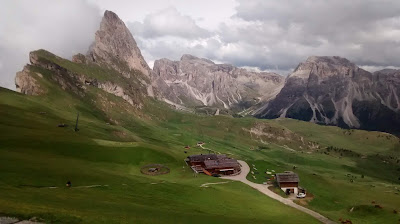According to a report produced by the Economic and Social Research Council, 27% of the privately owned land in Scotland is Sporting Estates. This constitutes 43% of the Highlands and Islands. As you can see from this image taken from the report, of the 218 Estates, 66% are owned by absentee landlords.
For years now, unsightly roads have been appearing all over the Highlands. Landowners claim that these are for agricultural purposes and no doubt they sometimes are, but often this is just a way to avoid the need to get planning permission. To quote from a report produced by the LINK Hill Tracks Campaign:
"The Campaign has reviewed location plans for many tracks claimed to be for agricultural use which, when cross-referenced to OS maps and aerial photos, clearly show the presence of grouse butts, thereby raising concerns as to their likely primary use. Claims of agricultural use can also be made when the more likely purpose is deer stalking, potentially illustrated by the following statement which was noted in sales particulars for the Ledgowan estate near Achnasheen in Wester Ross. 'Accessibility to the majority of the hill ground has been transformed by the construction of a network of hill roads. This significantly expands the scope of the stalking to enable those of all levels of physical fitness ...'"
The report includes many pictures, including one of mine (below) showing just how unsightly these tracks are and many are constructed so badly that they are damaging the ecosystems by causing water to run off the land faster causing even further damage as in Glen Falloch.
 |
| Sign by track at Drumochter urging walkers to help conserve the countryside, photo taken June 2017 |
In order to build the dam you need a track to get the machinery up to it and to maintain it and the pipeline. The feed-in tariff was scrapped in April 2019 but produced what the BBC described as a 'gold rush' for hydro power. If you joined before it closed your payment was index-linked for 20 years!
Considering the environmental damage, do these mini hydro-schemes make sense. Clearly they make business sense for the landowner but do they make sense for the rest of us? The run of the river schemes that I am talking about generate less than 5 MW of electricity. You can search the Renewable Energy Foundation Database to see how much power all of the Scottish Commercial Hydro Schemes smaller than 5 MW collectively produce. The result is about 154 MW.
The average UK home uses about 3.5 KW. So this powers about 44,000 homes (1.8% of the homes in Scotland). Most hydro hardware manufacturers quote design lives of 25 years - not that long. Wouldn't we be better off using tidal power?
"The crown estate and Scottish government are behind a £4 bn project to build a number of tidal power sites around the Orkney islands and the Pentland Firth, expected to generate the same amount of power as a nuclear power station. That's 1.2GW of green energy - enough to power up to 750,000 homes.
Some estimates have suggested that a combination of tidal and wave power from the area could produce up to 60GW of power. That would represent 10 times Scotland's annual electricity usage. Other studies suggest one-third of the UK's total electricity needs could be met by tidal power alone."
Have these landowners really been converted to using their land for green electricity? If you do use your land for deerstalking or grouse shooting, that subsidised track is very handy!
There is a campaign against these hilltracks. You can read more about it here. Disappointingly, in June 2019, MSPs voted against including new hilltrack legislation in the Planning Bill. It won the support of Green, Labour and Liberal Democrat colleagues, but SNP and Conservative MSPs joined forces to vote against the changes.
You can help by taking photos of new tracks or tracks of concern and sending them to hilltracks@scotlink.org or sharing the photos on social media using #HillTracks. Also, if you live in Scotland, you can write or speak to your elected representatives in the Scottish Parliament and/or your local authority.
If you would like to read more about this, read this article by Helen Todd of Ramblers Scotland. I'll quote some of it below:
"Why do we need stronger laws?
Environmental damage: We're seeing vehicles tracks that cause permanent scarring to landscapes, including SSSIs, rare habitats and important peatland environments.Industrialising the countryside: Tracks are creeping further and further into Scotland's wilder areas, industrialising special environments and impacting on people's outdoor experience. This includes vehicle tracks bulldozed near the summits of popular Munros.
Bad build quality: Due to the lack of oversight, construction standards are often poor. This results in 'rubble' tracks that wash away during heavy rain, deep banks that are too step to re-vegetate and inappropriate materials including visible plastic piping.
Democratic deficit: Perhaps the biggest issues is fairness. These tracks symbolise the abuse of privilege by many landowners. While ordinary people need to apply for planning permission to build modest extensions to their houses, tracks are being bulldozed up mountainsides causing permanent scars with no public oversight.
Tracks can have several uses, and we completely acknowledge that some can be useful for mountain-biking and walking – although sadly many have been built over the top of existing narrow, low-impact trails, including historical routes.
However, the current system offers no opportunity for the public to weigh up the pros and cons of potential new tracks."























